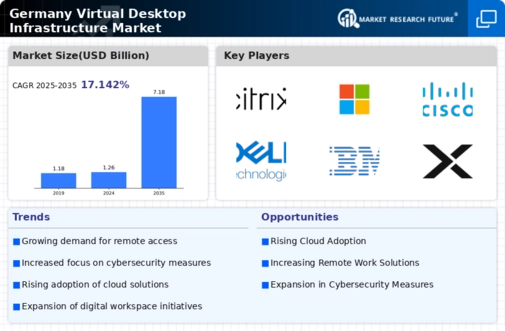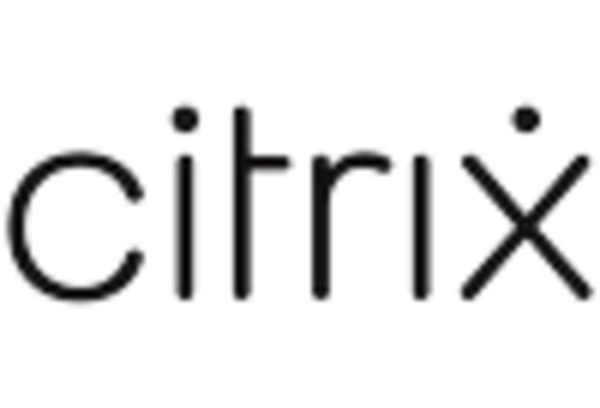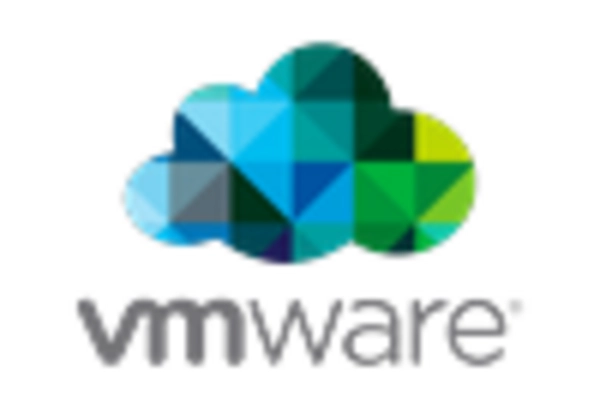Rising Cybersecurity Concerns
Cybersecurity remains a critical concern for organizations in Germany, significantly impacting the virtual desktop-infrastructure market. With increasing incidents of data breaches and cyberattacks, companies are prioritizing the protection of sensitive information. it offers a solution by centralizing data storage and management, thereby reducing the risk of data loss. Recent statistics indicate that 70% of German businesses consider cybersecurity a top priority in their IT strategy. This heightened focus on security is driving the adoption of virtual desktop solutions that provide enhanced security features, such as encryption and multi-factor authentication. As organizations strive to safeguard their digital assets, the demand for secure virtual desktop environments is expected to grow, further propelling the virtual desktop-infrastructure market.
Increased Focus on Cost Efficiency
Cost efficiency is becoming a driving force behind the adoption of virtual desktop solutions in Germany. Organizations are increasingly seeking ways to optimize their IT expenditures while maintaining high levels of productivity. The virtual desktop-infrastructure market offers a compelling value proposition by reducing hardware costs and simplifying IT management. Studies indicate that companies can save up to 30% on IT costs by transitioning to virtual desktop environments. This financial incentive is particularly appealing to small and medium-sized enterprises (SMEs) that may have limited budgets for IT investments. As businesses recognize the potential for cost savings and improved resource allocation, the demand for virtual desktop solutions is expected to rise, thereby contributing to the growth of the virtual desktop-infrastructure market.
Growing Demand for Remote Work Solutions
the market in Germany is experiencing a notable surge in demand for remote work solutions. As organizations increasingly adopt flexible work arrangements, the need for secure and efficient remote access to desktop environments has become paramount. According to recent data, approximately 60% of companies in Germany have implemented or are planning to implement remote work policies. This shift necessitates robust virtual desktop solutions that can support diverse workforces while ensuring data security and compliance. The ability to provide employees with seamless access to applications and data from any location is driving investments in virtual desktop technologies. Consequently, this trend is likely to bolster the growth of the virtual desktop-infrastructure market, as businesses seek to enhance productivity and maintain operational continuity in a rapidly evolving work landscape.
Regulatory Compliance and Data Governance
Regulatory compliance and data governance are increasingly influencing the virtual desktop-infrastructure market in Germany. With stringent data protection regulations, such as the General Data Protection Regulation (GDPR), organizations are compelled to adopt solutions that ensure compliance. The virtual desktop-infrastructure market provides a framework for managing data securely and efficiently, enabling businesses to adhere to regulatory requirements. Approximately 75% of German companies report that compliance with data protection laws is a significant factor in their IT decision-making processes. This emphasis on compliance is driving the adoption of virtual desktop solutions that offer robust data management capabilities. As organizations navigate the complexities of regulatory landscapes, it is likely to benefit from heightened demand for compliant solutions.
Advancements in Technology and Infrastructure
Technological advancements and improvements in IT infrastructure are playing a pivotal role in shaping the virtual desktop-infrastructure market in Germany. The proliferation of high-speed internet and the availability of advanced hardware are enabling organizations to deploy virtual desktop solutions more effectively. Recent reports suggest that over 80% of German enterprises have upgraded their IT infrastructure to support modern virtualization technologies. This trend is facilitating the seamless integration of virtual desktop environments into existing systems, enhancing performance and user experience. Furthermore, the emergence of 5G technology is anticipated to further accelerate the adoption of virtual desktop solutions, as it promises faster connectivity and reduced latency. As organizations leverage these technological advancements, it is likely to witness substantial growth.

















Leave a Comment